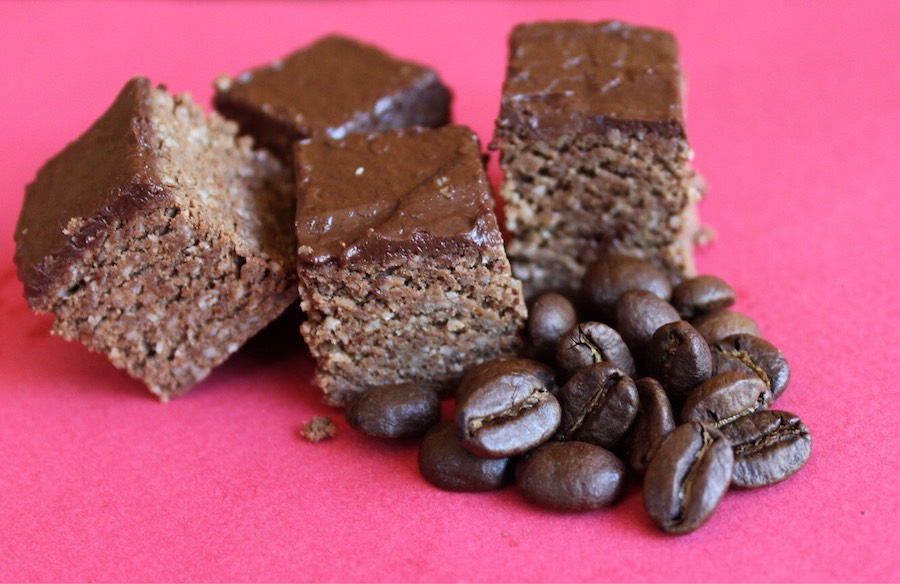
A UC Davis project is turning food that would normally be thrown away into more edible and appealing products
Mocha bites, bite-sized snacks made of almond pulp and chocolate, are vegan and gluten-free. The product is not available in stores, but has showed up at San Francisco’s Fancy Food Show and was in UC Davis’ Big Bang! Business competition. There’s one little caveat though; this tasty snack is actually made from food waste.
“A lot of it is consumers really understanding about food and really changing the idea, because it is termed ‘waste’ even though it’s not waste, there’s nothing wrong with the product,” said Maddison Gurrola, the creator of mocha bites.
When making food products, there is often a lot of waste. For example, when almond milk is made, almonds are squeezed and the liquid is collected. However the leftover mash, termed almond pulp, is still good to eat, but it isn’t utilized. Products like this often end up in animal feed or can be thrown away. Edward Spang created an internship program in the food science department to challenge undergraduate students to think about how to utilize this ‘food waste’.
“This project [internship program] came out of a conversation with the chief executive officer of Urban Remedy, which is a juice company in Richmond, California…in the juicing process, there’s quite a bit of high quality food residue left after, you know, you juice fruit and vegetables,” Spang said. “So everyday he was looking out the loading dock and looking at all of this carrot pulp, and beet pulp and kale pulp that was heading off towards mostly animal farms as waste from their food processing system.”
In fall 2016, Spang helped put together a team of five interns, and they started brainstorming. The team met with mentors, such as Lauren Shimek and Charlotte Biltekoff, who helped them figure out how to approach the challenge.
“They [Shimek and Biltekoff] taught us design thinking, which is this way to approach a process with a human centered focus,” Gurrola said. “So we really wanted to make sure that the products we were making fulfilled some form of value for our target customer.”
After thinking about what type of customer would be most interested in this sort of product, each team member formulated a food item and helped each other improve their ideas.
“We were all giving ideas,” said Lucas Baker, a former team member. “We have this pulp, let’s do something about it. Once we formulated on our own, we picked three different products that were the best ones, and then with those three different products, we went into doing sensory.”
Baker had to step away from the team due to scheduling issues, but he appreciates the time he spent as an intern.
In food science, sensory lab is a general term used to test different aspects of a food product, such as overall taste appeal. Other variables to consider are the ability to create large quantities of product and food safety.
The top three items the team created were an earth bar, a carrot cake bar and the mocha bites. Baker created the earth bar from beet roots, carrot pulp and almond pulp and it was similar to granola bars. The carrot cake bar was made from carrot pulp and was created as a sweet refrigerated snack.
In spring of 2017, the team entered the Big Bang! Contest after a special challenge award was announced, with prize money going towards the project that “did more with less”. Since the mocha bites had the fewest food safety issues and seemed the most viable product, the team worked on building a business model around the bites. They tied for first place in the contest and received funding from the Kaiser Family Foundation.
In this most recent school year, Gurrola and Spang have been investigating questions they had about mocha bites. Experimenting with different flavors, getting more public feedback and showcasing the item has been at the forefront of their to-do list.
According to Spang, food waste is growing in importance, and just a handful of companies right now are focused on it. Gurrola believes that transforming food waste into edible products is at the cutting edge of food trends.
Recycling or repurposing waste in this way is very beneficial. It reduces energy and needs to supply food to people, and helps the environment by reducing the amount of food that is thrown away. Presently, food waste does make it into animal feed. Spang says that it would take major advancements in food upcycling to greatly affect the amount of feed farm animals get. Additionally, the Environmental Protection Agency has addressed this concern with a hierarchy of what takes priority when food loss and waste is involved.
“The top priority is to prevent food loss and food waste in the first place,” Spang said. “If you’re not going to prevent it, so you’re making something like juice and people want juice, there’s going to be food loss and food waste. The next important thing is to feed humans. And so directing it back into the food chain would be more important. And then the next step would be to feed animals.”
There is value in making sure farm animals get fed, but it is more advantageous to use this food to feed humans. Both Spang and Gurrola hope more companies will use food waste in their products.
“So if we can get people excited, it’s environmentally great, nutritionally it’s great, it’s kind of closing one of the circles in the food system,” Gurrola said. “Hopefully we will see more of it on the market.”
Written by: Rachel Paul— science@theaggie.org



